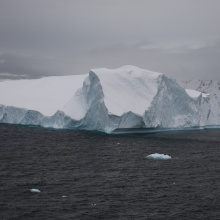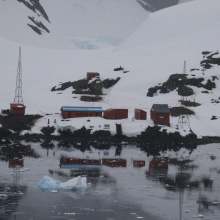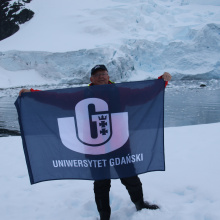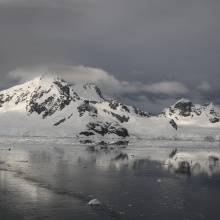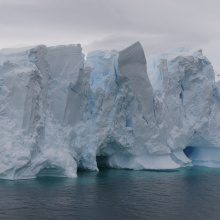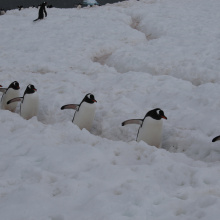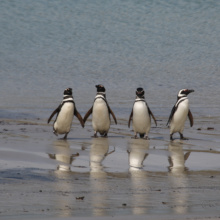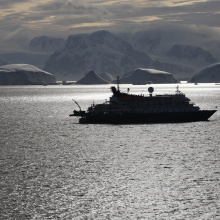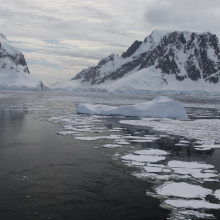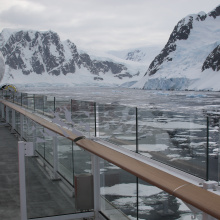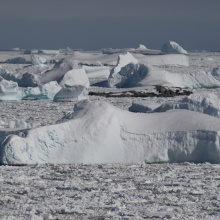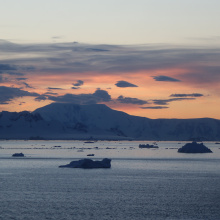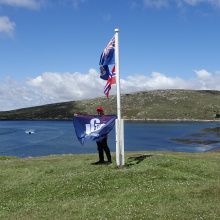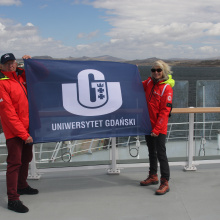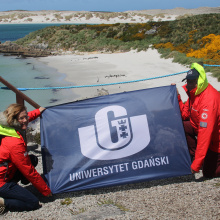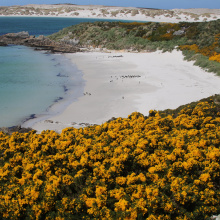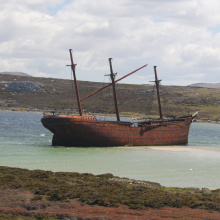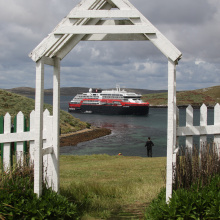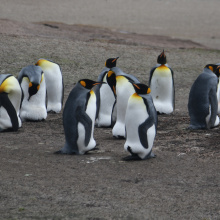Professor Tadeusz Palmowski from the Institute of Geography of the University of Gdańsk spent the end of November and the first half of December 2019 participating in an expedition to Antarctica. The journey began and ended in the Chilean port of Punta Arenas. The expedition took place onboard MS Roald Amundsen, a modern hybrid expedition cruise ship in service since 2019. The vessel is specially designed and adapted for cruises in polar waters, hence the name of the ship's patron. It is a convenient base for nature and travel lovers to explore exceptionally spectacular places in the most sustainable way. Onboard is a Science Centre equipped with high-class microscopes for biological and geological research and an abundant library dedicated to the Arctic and Antarctica.
The voyage led through the Beagle Channel and the first stop was Cape Horn. Then, after crossing the Drake Passage, the ship docked at Yankee Harbour on Greenwich Island in the South Shetland Islands. The crew could first set foot on the Antarctic continent at the Argentine Brown Antarctic Base. The next port of call was Danco Island quite near a colony of Gentoo penguins. The crew took a boat cruise among the icebergs in the area. It was also where we managed to take fantastic underwater photos with an underwater drone.
After crossing the ice-filled majestic Lemaire Channel and passing a giant iceberg, a whale and Adélie penguins, we visited the Ukrainian Vernadsky Research Base.
Then the ship reached Damoy Point. The view of the snow-covered Seven Sisters mountain range was stunning. We also observed Gentoo penguins there. On the way, we passed the British historic hut Damoy Hut, filled with old scientific equipment. Later in the course of the voyage, we saw Port Lockroy, a British research station and the southernmost post office.
Reaching the next place of call involved going through the naturally eroded Neptuns Bellows entrance to the inner volcanic caldera of Deception Island. In the raw-looking landing area of Pendulum Cove (whose name comes from the magnetic pendulum made in the early 1800s) water vapour rises where cold water meets hot rocks. Chinstrap and Gentoo penguins and skuas chose this location too.
Over the next day, the ship reached Point Wild on Elephant Island, a historic site in Antarctica, where the participants in Shackleton's expedition spent almost five months in 1916 living under two wooden boats awaiting rescue. A cruise on Expedition Team boats by the huge glacier cliff side was just a foretaste of the harsh conditions this place can offer.
Accompanied by flocks of seabirds, we passed the quiet part of the Drake Passage and the next day - with strong winds - we reached Stanley, the capital of the Falkland Islands.
Passengers took numerous trips to discover the history of the region in the city and the museum, visit sheep farms and see Bluff Cove with its rich birdlife and royal penguins, or the beautiful, rocky Gipsy Cove with Magellanic penguins and flowery vegetation.
Another breathtaking landing site was Sauders Island near the West Island in the Falkland Islands. On the slightly convex terrain, between two beautiful sandy beaches, numerous species of birds lead a busy family life. Large colonies of Gentoo penguins. A small but extremely charming colony of King Penguins. Higher up, nearby an uphill path, Magellanic penguins, Rockhoppers and albatrosses could be spotted in burrows. We also saw whole goose families and wading birds. Birds of prey patrolled the whole area. There was also a moss-covered skeleton of a sei whale. Sounds, fragrances and evolving life around produced a magical impression.
The picturesque sheep farm on West Point Island was the last port of call. It was windy but sunny. After a three-kilometre trip through the green if not idyllic island we reached the rocky edge of the cliff and saw an immense colony of birds and newly hatched chicks of rockhoppers living among albatrosses and petrels. We enjoyed the beautiful view from the nearby steep mountain and then went to the beach where numerous penguins were staying. Later, hospitable farm owners opened their home and welcomed us with cake, coffee and tea in a sunny garden surrounded by greenery.
The last day at sea we crossed the calm Drake Passage and when the ship entered the wide part of the Strait of Magellan we admired the high cliffs. After sailing 2840 nautical miles, Roald Amundsen called at Punta Arenas, where the voyage ended.
During the expedition, its participants from 23 countries listened to lectures and took part in practical classes on the polar environment. The classes covered the history of geographical discoveries of these areas, ornithology, marine biology, oceanography, meteorology, geology, glaciology and other issues and turned the ship into a scientific platform popularizing the marine ecosystem and sustainable development while offering polar tourism. One of the issues discussed in the lectures was the composition of the Antarctic food network, which classically requires a relatively short energy transfer by organisms compared to other areas of the world.
The crew of the polar expedition engaged passengers in polar science. One of the projects, FjordPhyto of the Scripps Institution for Oceanography in San Diego, California, consisted in passengers gathering information about phytoplankton and cold glacial waters during the cruise. Participants took samples from Antarctic fjords. In addition to participating in civic science projects, the ship's owner directly cooperates with such scientific institutions as the Norwegian Polar Institute, the Norwegian Institute of Maritime Research and the University Center in Svalbard (UNIS) to engage scientists on board so they can conduct research, contact tourists and share knowledge. It is an excellent form of cooperation and bringing science and tourism closer together.
Cruise participants enriched their knowledge and experience as they got to know and understand the polar region to a much greater extent. Their commitment turned them into real ambassadors who returned home ready to defend our planet's most vulnerable ecosystems. The rich documentary material from this cruise brought by professor Tadeusz Palmowski will be used for scientific and didactic purposes at the University of Gdańsk.

